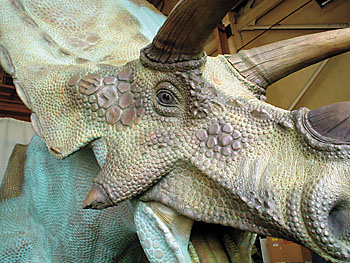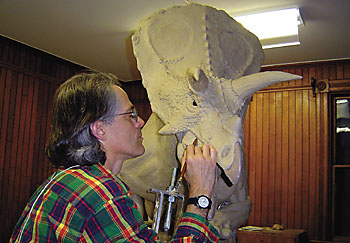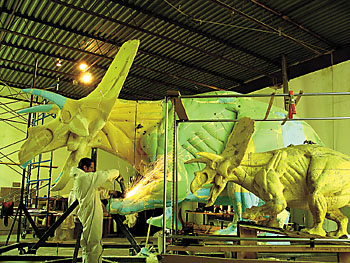 | Unlike dated images of dinosaurs as slow and dim-witted, the Torosaurus statue at the Yale Peabody Museum imagines the beast as sleek, muscular and "fairly intelligent." |
When the white shroud is lifted off the massive, 7,350-pound bronze sculpture of Torosaurus in front of the Yale Peabody Museum of Natural History, the team of museum staff, artisans and volunteers who worked on the project in its various stages over a five-year period will have answers to some of their final questions about the prehistoric beast.
Will the public like it? And, will the relatively unknown Torosaurus dinosaur ignite the imaginations of children and become as loved as its prehistoric brethren Tyrannosaurus rex, Stegosaurus, Triceratops and Apatosaurus (Brontosaurus)?
"I hope so," comments Michael Anderson, the Peabody museum preparator who sculpted Torosaurus and oversaw the dinosaur's creation at every stage of the process. "We'll have to see what kind of public reception there is for it."
Members of the public will have their first look at the 9-foot-tall, 21-foot-long dinosaur, which stands atop a 13-foot-high granite base, on Saturday, Oct. 22, following a morning dedication ceremony for invited guests. From 1 p.m. to 4 p.m., there will be assorted family-friendly crafts and games open to all, including The Great Peabody Museum Fossil Dig, a Torosaurus Skull Beanbag Toss, Make-Your-Own Torosaurus Clay Sculpture, and Torosaurus hat-making and badge-making. By the time these free activities begin, the Torosaurus sculpture will have been unveiled, allowing the public a close-range view of the giant sculpture on the front lawn of the museum, 170 Whitney Ave.
The idea for the Torosaurus sculpture was born back in 1999, when the Peabody's then-director Richard L. Burger and curator of vertebrate paleontology Jacques Gauthier approached Anderson about creating a dinosaur sculpture for the front lawn that could serve as a museum icon.
Anderson, a member of the Peabody staff since 1988 who has an extensive background in comparative anatomy and is noted for his human reconstructions, was asked to submit several proposals for the sculpture -- which, it was agreed, would be one of the 16 dinosaurs first described by O.C. Marsh. Marsh, who was a curator at Yale from 1867 to 1899, was the first professor of paleontology in the United States. The Peabody Museum was built with funds from Marsh's uncle, the financier George Peabody, to promote the natural sciences at Yale and to increase the University's collection of zoological specimens, fossils and minerals.
"Torosaurus just jumped out because it is this lesser-known dinosaur which at the time had not been reconstructed full size," says Anderson. "It lent itself to sculpture with its great body mass and unusual -- almost eccentric -- features. It has a nasal horn like a rhinoceros and a beak like a bird. It's a bizarre creature, and I was really drawn to it."
Burger, in turn, was immediately taken with Anderson's 11-inch model of the dinosaur on a rock. "That's it," he said of the museum preparator's proposal, Anderson recalls.
Since a complete skeleton of Torosaurus has never been found, Anderson used the few skulls that are known (including two at the Peabody) and specimens from the body of the closely related Triceratops to create a skeleton of the dinosaur, scaled to one-third of its actual size. During this part of the process, he worked closely with paleontologist Ralph Chapman, then of the Smithsonian Institution, which had remounted a Triceratops skeleton.
Creating the skeleton using a rigid polyurethane foam, and later sculpting the musculature in clay over the dinosaur's bones, was a painstaking process that took several years and required extensive research, as well as consultations with scientists worldwide. In addition to reading scientific literature about the skeletal anatomy of Torosaurus, Anderson dissected reptiles and birds that are believed to be close relatives of the dinosaur to "get living information about its musculature," says the sculptor, who collaborated with Gauthier throughout his reconstruction and also worked with museum assistant Dan Brinkman and a crew of Yale graduate students who study extinct reptiles.
Even though there are extensive fossils of Triceratops, a close relative of Torosaurus, and some Torosaurus fossils, there was a significant amount of guesswork involved in the reconstruction of the dinosaur's skeleton, notes Anderson. While creating Torosaurus' rear legs, for example, he was stymied when a footprint fossil and information about the dinosaur's column-shaped legs didn't seem to mesh.
"I talked with a paleontologist from Stanford University, who described a similar anatomy in elephants, where the back knee joint adducts as the leg comes under the weight of the body," says Anderson. "It was a great epiphany. That was one of many discussions I had about the placement of the limbs, how they would attach to the body."
Once Anderson completed his one-third scale model, the next step was to create a full-sized replica.
George Mummert and a team of other artists from Lancaster, Pennsylvania, took over this part of the project using a state-of-the art method that involves marking the scaled-down model with "points," then multiplying them by three and copying them onto a larger frame to create a full-size model. Each of the 2,000 points was drilled into the full-size prototype -- made with polyurethane foam blocks -- to reproduce Anderson's model exactly. The museum preparator then worked with Mummert to apply a thin layer of clay to the foam surface of the full-size model.
"Enlarging a sculpture to monumental proportions has been going on for centuries," Mummert has said of the process, adding that the best-known examples are Egyptian monuments. Of the new full-size model of Torosaurus, Mummert says, "This will be a definitive picture of Torosaurus based on new research, rather than what people see in movies."
The next step in the process was to texture and apply the skin to the full-sized model. Since there is scant information about what the skin of the Torosaurus might look like, Anderson once again studied living animals, particularly reptiles and birds, for clues.
"I was looking at everything as we made decisions about such things as skin folds, how they would look on Torosaurus," he says. To help create the patterns on the skin, Anderson used a cast of a rare fossilized impression of the skin of another horned dinosaur, Chasmosaurus, and studied scale patterns with Gauthier and his then-graduate student Takanobu Tshuihiji. Skin patterns were made on the clay, and, in yet another finely detailed and labor-intensive process, the dinosaur's scales were individually pressed and smoothed onto the sculpture.
"Every step of the way, we thought long and hard, consulting with other scientists and relying on the available scientific evidence," says Anderson, who also relied on the help of assistant sculptor Mike Ferrara. "We were conscientious about even the smallest details."
Anderson acknowledges, however, that some parts of his creation are based on conjecture, "educated guesses based on our knowledge of Torosaurus' evolutionary relationships with living animals," he says. He adds that the dinosaur's horn is one such mystery, noting that no one knows if its surface is like that of a bison, a chameleon or a rhinoceros.
In the final stage of the Torosaurus reconstruction, the dinosaur was cast in bronze at Polich Art Works (owned by Yale alumnus Dick Polich '54) in Rock Tavern, New York, from a rubber mold of the full-scale clay sculpture. The mold comprised 54 individual pieces, which were covered with 2,000 pounds of rubber followed by 4,000 pounds of plaster, burlap and conduit. Wax casts were created from the mold, and these casts were then dipped in a ceramic and silica mixture, and later embedded in a sand-filled vat. Molten bronze -- heated to about 2,000 degrees Fahrenheit -- was then poured into the mold.
Anderson made his final artistic decision when he selected the patina to coat the bronze statue.
Once completed, the Torosaurus sculpture returned to its birthplace at the Peabody, where it was lowered by crane on its granite base. The base was created by local sculptor Darrell Petit with assistance from Anderson and is made from 70 tons of pink granite mined from a quarry in Stony Creek, Connecticut -- the same granite used to make the base of the Statue of Liberty.
Since its arrival in New Haven several weeks ago, the sculpture has attracted a great deal of conversation as its stands mysteriously beneath its white drape.
Those who have been a part of the sculpture's laborious creation are eager to show it off to the world.
""We all feel very proud of it," says Anderson, whose Torosaurus sculpture is his biggest project of this kind at Yale to date. He has also created a reproduction of Neanderthal man for a Peabody exhibit and was asked by National Geographic to reconstruct the face of King Tutankhamen based on new information from CT scans of the famous mummy.
Anderson, whose artistry can also be observed in Peabody dioramas, is most pleased that his newest sculpture for the museum reflects the evolution of scientific thinking about dinosaurs. While once thought to be "slow-moving, dim-witted beasts," his Torosaurus is sleek, muscular and "looks fairly intelligent," he explains.
The giant dinosaur sculpture will be surrounded by a "Cretaceous garden," featuring trees and plants, such as magnolias and ferns, which existed during the period.
The Torosaurus project was funded by a donation from Elizabeth and Stanford Phelps '56 and their grandchildren Max, Garrett and Ford.
For the hundreds of schoolchildren and others who visit the Yale Peabody Museum -- already world-famous for its giant "Age of Reptiles" mural by Rudolph Zallinger and its Great Hall of Dinosaurs -- the Torosaurus sculpture will become one more emblem of the place, representing not only a period in the Earth's past but also a melding of contemporary art and science.
-- By Susan Gonzalez
T H I S
From bones to bronze: Building Torosaurus

Because a complete skeleton of Torosaurus has never been found, Peabody curator Michael Anderson relied on information about related dinosaurs and modern-day animals to create his model of the prehistoric beast.
As Anderson examined Marsh's various fossil finds, he was immediately taken with the skull of Torosaurus, a horned dinosaur with a large frill (a sheet of bone at the back of the skull) that lived at the end of the Cretaceous Period 65 to 66 million years ago.
From small to big

George Mummert from Lancaster, Pennsylvania, oversaw the enlargement of the Torosaurus model from one-third size (foreground) to full size (background) using a state-of-the-art technique that ensures an exact reproduction of the original.
The final result, Anderson says, is a creation that is as true as possible to the real prehistoric beast.
The bronzing of the beast
 W E E K ' S
W E E K ' S S T O R I E S
S T O R I E S![]()
 Archaeologist's discovery may be final clue to location of long-lost Maya city
Archaeologist's discovery may be final clue to location of long-lost Maya city![]()
![]()
 Materials research center established with $7.5 million NSF grant
Materials research center established with $7.5 million NSF grant![]()
![]()
 Annual festival lets local artists showcase their works
Annual festival lets local artists showcase their works![]()
![]()
 Yale community members will share their unique artistic visions . . .
Yale community members will share their unique artistic visions . . .![]()
![]()
 Message from the Leaders of the Yale United Way Campaign
Message from the Leaders of the Yale United Way Campaign![]()
![]()
 Welcome, Parents! A schedule of Parents' Weekend activities
Welcome, Parents! A schedule of Parents' Weekend activities![]()
![]()
 Matching fund for Katrina relief expanded
Matching fund for Katrina relief expanded![]()
![]()
 IN FOCUS: OFFICE OF SUSTAINABILITY
IN FOCUS: OFFICE OF SUSTAINABILITY
 New office adds energy to the drive for a 'greener' campus
New office adds energy to the drive for a 'greener' campus![]()
 One step at a time, student group hopes to change habits of peers
One step at a time, student group hopes to change habits of peers![]()
 Actions you can take to help make Yale a sustainable campus
Actions you can take to help make Yale a sustainable campus![]()
![]()
 'Skeptical' neurologist works to separate science from sham
'Skeptical' neurologist works to separate science from sham![]()
![]()
 Yale Rep launches its 40th season with 'The Cherry Orchard'
Yale Rep launches its 40th season with 'The Cherry Orchard'![]()
![]()
 Special packages for Yale community
Special packages for Yale community![]()
![]()
 Exhibition simulates viewing conditions intended by artists
Exhibition simulates viewing conditions intended by artists![]()
![]()
 Noted graphic designer Dan Friedman is subject of retrospective
Noted graphic designer Dan Friedman is subject of retrospective![]()
![]()
 MEDICAL SCHOOL NEWS
MEDICAL SCHOOL NEWS
 Study shows how hospitals can improve heart attack care
Study shows how hospitals can improve heart attack care![]()
 Aneurysm reduces risk of atherosclerosis, say researchers
Aneurysm reduces risk of atherosclerosis, say researchers![]()
 Scientists identify gene that controls severity of asthma
Scientists identify gene that controls severity of asthma![]()
 Report: Better training in telephone medicine needed
Report: Better training in telephone medicine needed![]()
 Discovery may help improve diagnosis and treatment of MS
Discovery may help improve diagnosis and treatment of MS![]()
 Study: Hypersensitive neurons at root of 'phantom pain'
Study: Hypersensitive neurons at root of 'phantom pain'![]()
 Study: Genetic factors for gambling, depression overlap
Study: Genetic factors for gambling, depression overlap![]()
 Program shown to curb high-risk behavior in teens
Program shown to curb high-risk behavior in teens![]()
 Physician: More research funding needed to prevent . . .
Physician: More research funding needed to prevent . . .![]()
![]()
 Divinity School alumni will honor memory of missing classmate . . .
Divinity School alumni will honor memory of missing classmate . . .![]()
![]()
 Audience will be 'postmodern detectives' in School of Drama play
Audience will be 'postmodern detectives' in School of Drama play![]()
![]()
 New visions of religious icons featured in ISM show
New visions of religious icons featured in ISM show![]()
![]()
 Exhibit celebrates life of Yale's first Native American alumnus
Exhibit celebrates life of Yale's first Native American alumnus![]()
![]()
 WFF will honor women leaders from around the globe
WFF will honor women leaders from around the globe![]()
![]()
 Annual festival will include music, talks and shadow puppetry
Annual festival will include music, talks and shadow puppetry![]()
![]()
 Study shows stigma of obesity influenced by attitudes of peers
Study shows stigma of obesity influenced by attitudes of peers![]()
![]()
 Book doctor
Book doctor![]()
![]()
 YUWO awards scholarships to 13 Yale affiliates
YUWO awards scholarships to 13 Yale affiliates![]()
![]()
 Yale Books in Brief
Yale Books in Brief![]()
![]()
 Campus Notes
Campus Notes![]()
Bulletin Home |
| Visiting on Campus
Visiting on Campus |
| Calendar of Events
Calendar of Events |
| In the News
In the News![]()
Bulletin Board |
| Classified Ads
Classified Ads |
| Search Archives
Search Archives |
| Deadlines
Deadlines![]()
Bulletin Staff |
| Public Affairs
Public Affairs |
| News Releases
News Releases |
| E-Mail Us
E-Mail Us |
| Yale Home
Yale Home